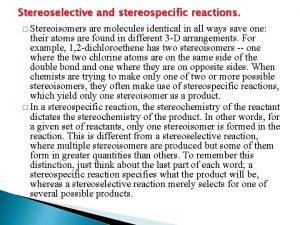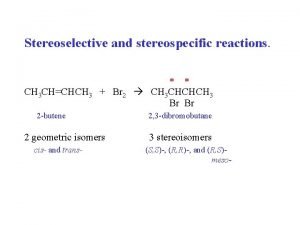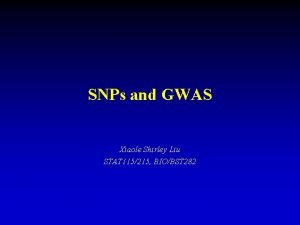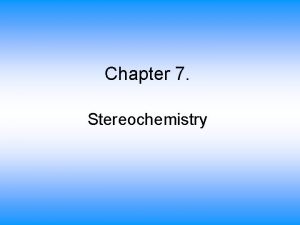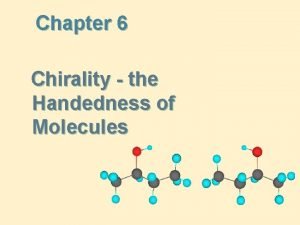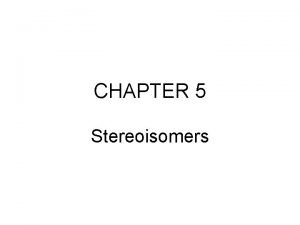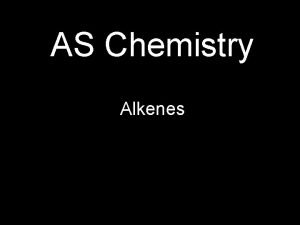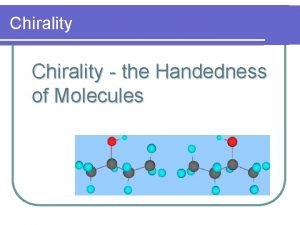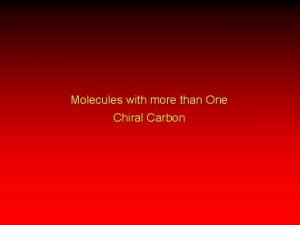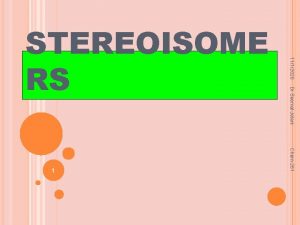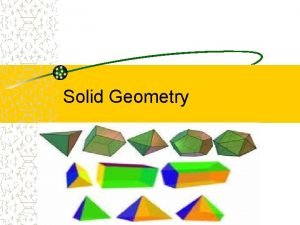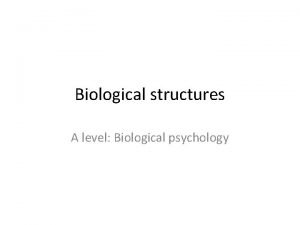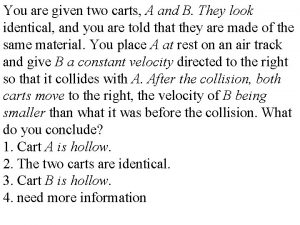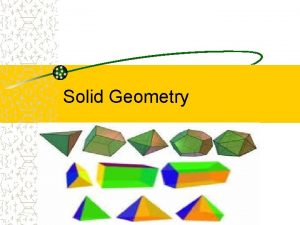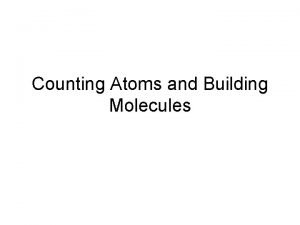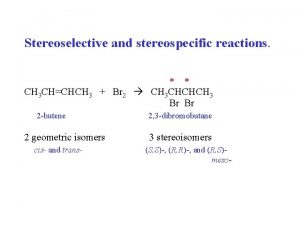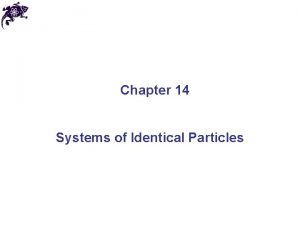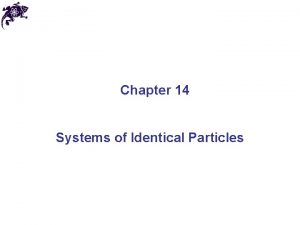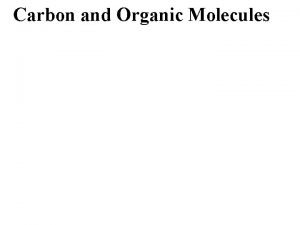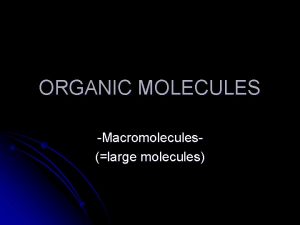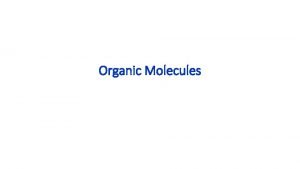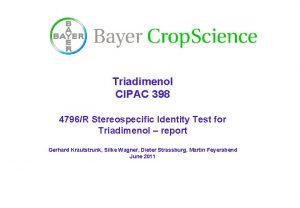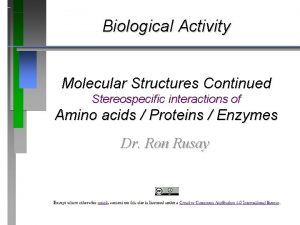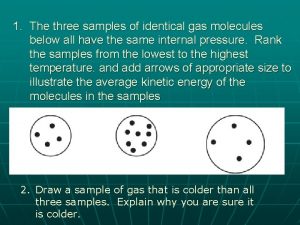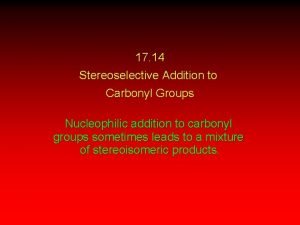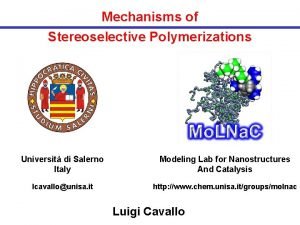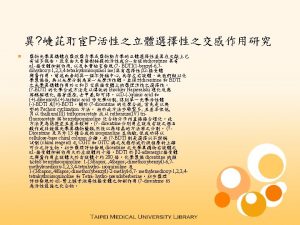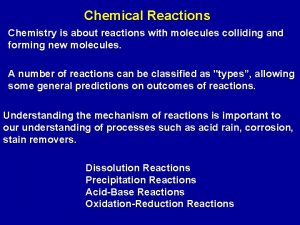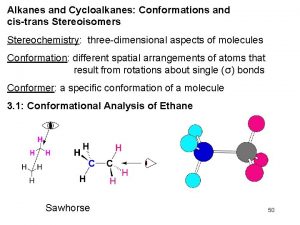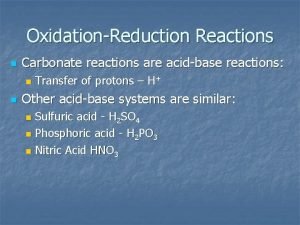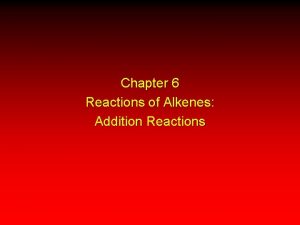Stereoselective and stereospecific reactions Stereoisomers are molecules identical

































- Slides: 33

Stereoselective and stereospecific reactions. � Stereoisomers are molecules identical in all ways save one: their atoms are found in different 3 -D arrangements. For example, 1, 2 -dichloroethene has two stereoisomers -- one where the two chlorine atoms are on the same side of the double bond and one where they are on opposite sides. When chemists are trying to make only one of two or more possible stereoisomers, they often make use of stereospecific reactions, which yield only one stereoisomer as a product. � In a stereospecific reaction, the stereochemistry of the reactant dictates the stereochemistry of the product. In other words, for a given set of reactants, only one stereoisomer is formed in the reaction. This is different from a stereoselective reaction, where multiple stereoisomers are produced but some of them form in greater quantities than others. To remember this distinction, just think about the last part of each word; a stereospecific reaction specifies what the product will be, whereas a stereoselective reaction merely selects for one of several possible products.

Stereoselective and stereospecific reactions. CH 3 CH=CHCH 3 + Br 2 2 -butene 2 geometric isomers cis- and trans- * * CH 3 CHCHCH 3 Br Br 2, 3 -dibromobutane 3 stereoisomers (S, S)-, (R, R)-, and (R, S)meso-

H CH 3 / C=C / CH 3 H CH 3 / C=C / H H trans-2 -butene cis-2 -butene CH 3 H Br Br H H Br CH 3 (S, S) (R, R) meso

CH 3 / C=C + Br 2 / CH 3 H trans-2 -butene H Br CH 3 meso-2, 3 -dibromobutane only product A reaction that yields predominately one stereoisomer (or one pair of enantiomers) of several diastereomers is called a stereoselective reaction. In this case the meso- product is produced and not the other two diastereomers.

CH 3 H / H C = C + Br 2 / Br CH 3 H cis-2 -butene Br Br H H Br + H CH 3 (S, S)- & (R, R)-2, 3 -dibromobutane racemic modification only products A reaction in which stereochemically different molecules react differently is called a stereospecific reaction. In this case the cis- and trans- stereoisomers give different products.

The fact that the addition of halogens to alkenes is both stereoselective and stereospecific gives us additional information about the stereochemistry of the addition and the mechanism for the reaction. Thus the addition of bromine is a stereospecific reaction—the product obtained from addition to the cis isomer is different from the product obtained from addition to the trans isomer. It is also a stereoselective reaction because all possible isomers are not formed.



Is the addition of Br 2 syn or anti?

H X H / C=C / CH 3 X | H H C — C CH 3 | X anti-addition of X 2 to the cis-isomer Note: must rotate about C-C to get to the Fischer projection! X | H H X H C — C CH 3 X C — C H CH 3 | | | X CH 3 X H H X CH 3

H X CH 3 / C=C / CH 3 X H X | CH 3 H C—C H CH 3 | X anti-addition of X 2 to the trans-isomer Note: must rotate about C-C to get to the Fischer projection! X | CH 3 H C—C H CH 3 | X CH 3 H H X C—C X | | CH 3 H X CH 3


Hydroxylation of alkenes: CH 3 CH=CHCH 3 + KMn. O 4 2 -butene 2 geometric isomers * * CH 3 CH-CHCH 3 OH OH 2, 3 -butanediol 3 stereoisomers

+ KMn. O 4 2, 3 -butanediol mp 34 o. C cis-2 -butene trans-2 -butene + KMn. O 4 2, 3 -butanediol mp 19 o. C 2, 3 -butanediol ( mp 19 o. C ) is separable into enantiomers. CH 3 H OH HO HO H H CH 3 H H OH OH CH 3 (S, S) (R, R) meso mp 19 o. C mp 34 o. C

cis-2 -butene + KMn. O 4 meso-2, 3 -dihydroxybutane mp 34 o CH 3 H OH CH 3 trans-2 -butene + KMn. O 4 (S, S) & (R, R)-2, 3 -dihydroxybutane mp 19 o CH 3 H OH HO H CH 3 stereoselective and stereospecific + HO H H OH CH 3

Is hydroxylation with KMn. O 4 syn- or anti-?

H O O CH 3 / C=C / CH 3 H OH OH | | H C — C CH 3 H syn-oxidation of the trans-isomer Note: must rotate about C-C to get to the Fischer projection! OH OH | | H OH H C — C CH 3 HO C — C H CH 3 H | | CH 3 HO H H OH CH 3

H O O H / C=C / CH 3 OH OH | | H C—C H CH 3 syn-oxidation of the cis-isomer Note: no rotation necessary to get to Fischer projection! OH OH | | H H H C—C H HO C — C OH CH 3 | | CH 3 H OH CH 3

+ HCO 3 H cis-2 -butene 2, 3 -butanediol mp 19 o. C trans-2 -butene + HCO 3 H 2, 3 -butanediol mp 34 o. C 2, 3 -butanediol mp 19 o. C is separable into enantiomers. CH 3 H OH HO HO H H CH 3 H H OH OH CH 3 (S, S) (R, R) meso mp 19 o. C mp 34 o. C

Oxidation with KMn. O 4 syn-oxidation cis-2 -butene meso-2, 3 -dihydroxybutane trans-butene (S, S)- & (R, R)-2, 3 -dihydroxybutane Oxidation with HCO 2 OH gives the opposite cis-2 -butene (S, S)- & (R, R)-2, 3 -dihydroxybutane trans-2 -butene meso-2, 3 -dihydroxybutane Oxidation with HCO 2 OH is anti-oxidation.

| | —C—C— | | O O Mn O O | | —C—C— O hydroxylation with KMn. O 4 is syn- because of an intermediate permanganate addition product. hydroxylation with HCO 2 OH is anti- because of an intermediate epoxide.

* * CH 2 -CH-CH-CH=O | | | OH OH OH Four carbon sugar, an aldotetrose. Two chiral centers, four stereoisomers

CHO H OH HO H CH 2 OH D-erythrose CH 2 OH L-erythrose CHO HO H H OH CH 2 OH D-threose CHO H HO OH H CH 2 OH L-threose

X X “erythro-” X X “threo-”

* * C 6 H 5 CHCHC 6 H 5 + KOH(alc) C 6 H 5 CH=CC 6 H 5 Br CH 3 1 -bromo-1, 2 -diphenylpropane 4 stereoisomers 1, 2 -diphenylpropene 2 stereoisomers (E)- & (Z)- dehydrohalogenation of an alkyl halide via E 2 mechanism

C 6 H 5 CH 3 H H CH 3 Br H H Br C 6 H 5 erythro- CH 3 H C 6 H 5 H H CH 3 Br Br H C 6 H 5 threo- C 6 H 5 CH 3 / C=C / H C 6 H 5 / C=C / H CH 3 (E)- (Z)-

C 6 H 5 CH 3 H H CH 3 Br H H Br C 6 H 5 erythro- C 6 H 5 KOH(alc) C 6 H 5 / C=C / H CH 3 (Z)-

C 6 H 5 CH 3 H H CH 3 H Br Br H C 6 H 5 threo- C 6 H 5 KOH(alc) C 6 H 5 CH 3 / C=C / H C 6 H 5 (E)-

E 2 is both stereoselective and stereospecific. 100% anti-elimination of the H & Br: C 6 H 5 CH 3 Br H H C 6 H 5 erythro- CH 3 C 6 H 5 HO- Br | C—C H | C 6 H 5 H CH 3 H / C=C / C 6 H 5 (Z)-

C 6 H 5 CH 3 H H Br C 6 H 5 threo- CH 3 C 6 H 5 HO- Br | C — C C 6 H 5 | H H CH 3 C 6 H 5 / C=C / C 6 H 5 CH 3 (E)- Once again, you must rotate about the C—C bond in the Fischer projection to get the H & Br anti to one another.

E 2 is an anti-elimination. The hydrogen and the halogen must be on opposite sides of the molecule before the E 2 elimination can take place. This makes sense as both the base and the leaving group are negatively charged. Therefore they would try to be as far apart as possible. In addition, the leaving group is large and there is more room for the removal of the adjacent proton if it is on the opposite side from the leaving group.

Addition of halogens to alkenes anti-addition Cis-anti-threo Trans-anti-erythro Hydoxylation with KMn. O 4 syn-oxidation Cis-syn-erythro Trans-syn-threo Hydroxylation with HCO 2 OH anti-oxidation Cis-anti-threo Trans-anti-erythro Dehydrohalogena anti-elimination of alkyl halides E 2 Erythro-anti-cis Threo-anti-trans

One way to determine what stereoisomers are obtained from many reactions that create a product with two asymmetric carbons is the mnemonic CIS-SYN-ERYTHRO, which is easy to remember because all three terms mean “on the same side. ” You can change any two of the terms but you can’t change just one. (For example, TRANS-ANTIERYTHRO, and CIS-ANTI-THREO are allowed, but TRANS-SYNERYTHRO is not allowed. ) So if you have a trans reactant that undergoes addition of Br 2 (which is anti), the erythro products are obtained.
 Stereoselective and stereospecific reactions
Stereoselective and stereospecific reactions Stereoselective vs stereospecific
Stereoselective vs stereospecific Mikael ferm
Mikael ferm Identical by descent vs identical by state
Identical by descent vs identical by state Organic molecules vs inorganic molecules
Organic molecules vs inorganic molecules Section 2 reinforcement classifying chemical reactions
Section 2 reinforcement classifying chemical reactions Balancing redox reactions in acidic solution
Balancing redox reactions in acidic solution Section 2 classifying chemical reactions
Section 2 classifying chemical reactions Chemical reactions section 3 reactions in aqueous solutions
Chemical reactions section 3 reactions in aqueous solutions Unit 5 chemical reactions answers
Unit 5 chemical reactions answers Stereoisomers
Stereoisomers Superimposeable
Superimposeable Types of stereoisomers
Types of stereoisomers 2 3-dichloropentane stereoisomers
2 3-dichloropentane stereoisomers R and s configuration
R and s configuration Mirror image stereoisomers are called
Mirror image stereoisomers are called But-2-ene isomers
But-2-ene isomers 2 3 4-trihydroxybutanal stereoisomers
2 3 4-trihydroxybutanal stereoisomers 2 3-butanediol fischer projection
2 3-butanediol fischer projection 2 3 4-trihydroxybutanal stereoisomers
2 3 4-trihydroxybutanal stereoisomers Solid
Solid Genotype environment
Genotype environment Rita and holly are identical twins
Rita and holly are identical twins You are given two carts a and b
You are given two carts a and b Rita and holly are identical twins
Rita and holly are identical twins Rita and holly are identical twins
Rita and holly are identical twins A solid object with two identical ends and flat sides
A solid object with two identical ends and flat sides What is the relationship between atoms and elements
What is the relationship between atoms and elements Classify the following unbalanced chemical equations
Classify the following unbalanced chemical equations Properties of solid
Properties of solid Atoms elements molecules and compounds worksheet
Atoms elements molecules and compounds worksheet Relative configuration
Relative configuration How can you count atoms and molecules
How can you count atoms and molecules Polar and nonpolar similarities
Polar and nonpolar similarities
